
Losing track
I’d like to share with you an executive function hack.
Actually, this is a combination of executive function, as well as a way to acknowledge and celebrate progress in your personal growth journey.
OK, here’s the executive function part. I used to use habit trackers and star charts extensively, to keep me on track towards goals, or to build habits, or to remind me of things that I wanted to do consistently.
And in some ways, they were really helpful. I did find the reminder, and the minor accountability useful to push me to do something in order to get the star, or keep the habit chain going, but it also intensified my demand avoidance, and after a while, they kind of backfired.
Especially if I missed one day, it would be like “screw it, that just broke a 100+ day record, F-that, I’m never doing that again.” And I wouldn’t just stop using the habit tracker, I would often stop doing the thing that I was using the habit tracker to get myself to do. The thing that I originally wanted to do.
I would often stop doing the thing that I was using the habit tracker to get myself to do. The thing that I originally wanted to do.
My longest record was 953 days of meditation, as tracked by my meditation app, and then I had a really full day and only remembered a few minutes after midnight, and that broke the chain. And I didn’t go back to it for months.
But I did notice that I had felt better when I was meditating regularly, so I tried going back to it, but every time I opened the app, the home screen showed me that I was on day 10, or whatever, of my current chain, and that my longest chain was 953 days. And it just felt like a slap in the face every time.
Because it was going to take me years to go back up to that. So no matter how long I kept at it, for at least the next 2 1/2 years, it was always going to remind me that I had done better before, and that this wasn’t it.
And I completely realize that there is so much dirty pain in this, that I am putting a whole ton of meaning onto this that is creating extra pain by how I’m thinking about it. But that’s kind of my point. The way that these kinds of habit trackers work is by creating artificial accountability, as if it actually means something that you missed a single day, so that you will push yourself to do the thing just to keep this chain going that only has meaning because we attribute meaning to it. And the meaning that we attribute is usually some version of, “if I don’t keep it up, I have failed, or messed up, or didn’t try hard enough.”
Even when you have 953 frickin’ days in a row, that one time that you miss is a glaring, obvious, permanent thing that can never be fixed or remedied. No matter whether you were in the hospital, or busy, or decided that, for your own well-being, that something else was more important to you, or whatever the case was.
Depending on how the tracking system is set up, it’s either that you lose the chain, and have to start over again from the beginning, or like in star charts, there’s an empty spot where that star would’ve been on that day and you can never get that back. Because the day moves on and even if you do it the next day, even if you do it twice, it doesn’t fill that in, and you see that forever.
Leaving those trackers behind
After I figured out I’m Autistic, and started deconstructing my life, and seeing through the coercive systems that are built into our society, and understanding how this external accountability, that starts with our parents and teachers and other adults in a kids life gets internalized, and we end up doing it to ourselves (and I was really good at doing it to myself), anyway, after I started seeing through that, I went to the other end of the pendulum swing for a while and went really demand-avoidance, and threw out all forms of external accountability, including every habit tracker and star chart and, “if I do this, then I can reward myself with that.”
And that phase felt good for a while, but it was also an extreme counter reaction. After a while, I had worked through enough old wounds that I wasn’t as defensive, or demand avoidant, and on a practical level, I missed the way that those things could help my executive function to get stuff done, and felt like I was ready for a more moderate approach. Not throwing the baby out with the bathwater.
I started questioning what I liked about habit trackers, and realized that I liked the feeling of making progress, but I didn’t like the feeling of pressure. So I made a better version.
I made this for myself a few years ago, and have shared it on my website for free, which some people have found and downloaded, and I’ve gotten good comments about it, so I wanted to share it more widely and to make it easier to find and download—still free.
This is a hexagon chart.
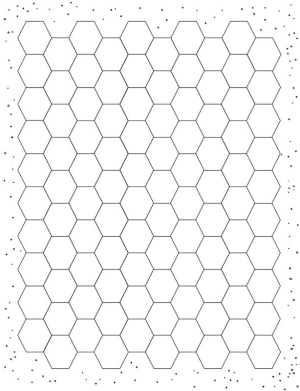
It’s like those star charts, but made out of hexagons. And it doesn’t have dates, so there’s no record of all the times that I “failed” to do this, so it doesn’t have that sense of pressure. It’s just that when I do something, I color in a hexagon, and then slowly, over time, the colors grow and I can see how much I did, without any of the how-much-I-didn’t-do, or the dates that I didn’t get it done, or the chains that were broken. Those just create stress, at least for me, but I like to see the record of how much I did.
And when I want to encourage myself towards some particular goal, or remind myself of how much I’m doing towards something, especially if the results are slow and cumulative over the long-term, and may not be super obvious right now, I’ll print out another hexagon chart for myself.
I’ll post it on my wall, or keep it on my desk, and have some colored pencils nearby, so it’s easy to color it in.
This is one I made when I was into micro fiction and was writing 100 word stories.
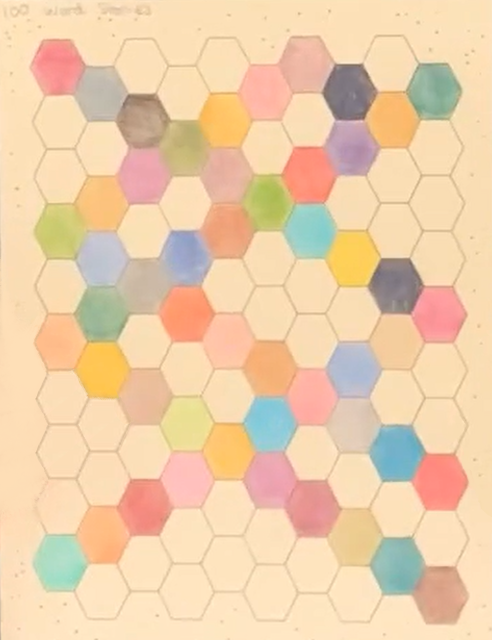
This one is for writing 1000 word stories.
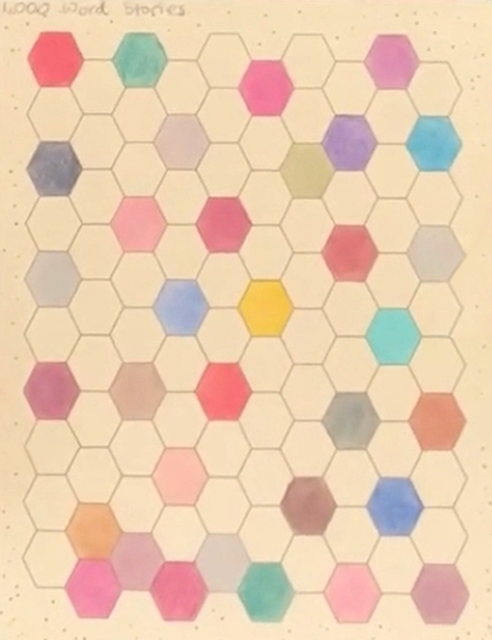
And, this one is for when I was procrastinating working on a presentation and was having trouble getting over the inertia starting, so every time I did a small step towards starting the presentation, I filled in a hexagon.
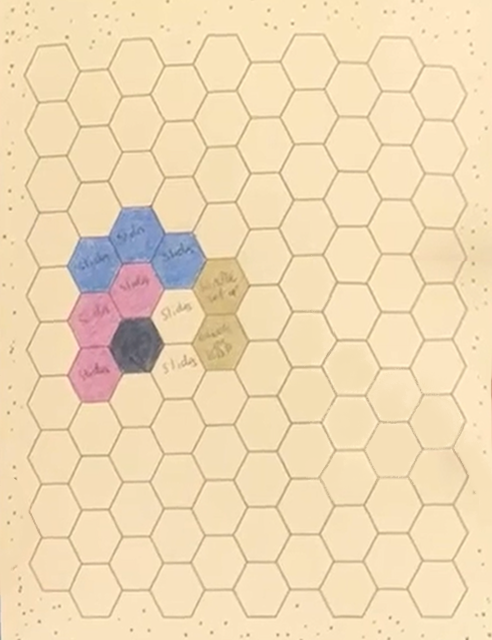
You’ll notice that none of these are completely filled in. And I allowed myself to let go of that completion goal. The presentation one helped me get started with the project, and that was enough. That was all I needed and that served its purpose. And then I found filling in the hexagons more cumbersome than not, but I was into the rhythm of doing the project, and didn’t need it anymore. So it served its purpose.
The stories I kept up for quite a while, for around a year in fact, and between the two, that was a lot of stories that I wrote in that year. And then I moved on to doing something else. And I decided that was okay. I didn’t need to keep writing stories just to fill in this chart. I’ve gotten what I wanted to out of it.
Sometimes I finish the hexagon chart, sometimes I don’t. I was looking around for old ones I had finished, and couldn’t find any to show you right now. I think there’s a couple in the back of my closet somewhere.
I don’t use this for every goal, but sometimes it’s useful to have that visual reminder of how much I have done, without the pressure of times when I haven’t done it. It’s a guilt-free progress tracker!
Ideas for you
Here’s a few ideas of ways that you might use it. And I’m curious to see what other ways that you come up with. Please share in the chat if you download it and find it useful, and especially if you come up with a new way to use it, please share those in the chat to give other people ideas as well.
As an executive function aid, you could use it for things like tracking your journaling, or practicing your instrument, or meditating, or other things that you might do once-a-day, or that you want to do a little more often than you are now. Or you might want to challenge yourself to see how quickly you can get to 50 days, or to 100 times, but without the guilt of the days or times when you don’t do it. Or without the challenge aspect, which I prefer. Just seeing that you have done a whole lot of stories (in my case) is nice. It’s not just files on a computer that are really easy to overlook.
It’s not just files on a computer that are really easy to overlook.
By the way, the download comes in two sizes, there’s a 50 hexagon half page and a 100 hexagon full page one. But if 50 or 100 is too much, you can fold or cut the page down to make it smaller. You could even just cut out one line of it to make five in a row.
When I need a little reinforcement that I really am getting things done, when it doesn’t feel like it, I’ll pair this with my to-do list. So that every time I tick something off my to-do list, big or small, I get to color in a hexagon. That way I can see the buildup of things that I HAVE done, not simply see them disappear off of my digital to-do list and only see the things that are yet to be done. That’s the one thing that I don’t like about digital to-do lists.
This is also a way to acknowledge and celebrate progress in your personal growth journey, for example, every time you hold a boundary.
Or to track the days when you’re feeling a little bit better in your burnout recovery journey, so that you can see that there have been days when you feel a little bit better (which is a nice reminder on the days when you’re feeling crappy).
Or to record the times when you’ve done something for yourself that you feel good about. Maybe you can fill in a hexagon when you take a step toward that goal you’ve set for yourself. Or each time you’ve done a little artwork, or music, or done something towards building your business, or when you’ve studied, or done your homework. With this, it doesn’t have to be once-a-day. It can be whenever-it-happens.
Or here’s a different idea, if you’re trying to undo some old pattern of negative thoughts about someone else, that you know is untrue and unfair to them, maybe you can color in a hexagon every time that they do or say something kind to you, as a reminder that they do do that sometimes. Just to be clear, this is not to be used to gaslight yourself into excusing bad behavior, but when you have unfair negative thoughts about someone that you want to feel better about.
Or maybe this idea, color in a hexagon when you DON’T do something that you’re trying to get out of the habit of doing. Those are exactly the kind of things that tend to be irregular, or inconsistent, not regular once-a-day kinds of things, so they don’t work as well with daily habit trackers. But if you still want to get credit for NOT doing that thing, this can show you, over time, how much you’ve NOT done it. It doesn’t have to be every single time. Maybe you still do it occasionally. But there are more and more times when you haven’t done it, and you get credit for each one, and can see it visually building up over time.
Where to download
Okay, these are just a few examples of how I’ve used it. If you’re interested, you can download it at www.autismchrysalis.com/hexagon.
Full disclosure upfront, it will ask you to enter your email address, to send you the PDF by email. And you’ll also get my email newsletter every other week about building your autism and AuDHD friendly life. If you don’t want that, you can unsubscribe anytime.
By the way, if you’re also demand avoidant, like me, and hate giving out your email address for PDF downloads, it’s not required. There is a place on my website where I post free stuff, and you can download it directly. I set up this email version because it’s simpler for a lot of people, and email is a great place to save things, and I hope that some people will actually appreciate getting my newsletter. I get great reviews about it. And, like I said, it’s only an option.
I hope this hexagon chart is useful for you as a guilt-free progress tracker.
Why is there backlash?
By the way, if you’re interested in why this backlash reaction happens, where, when you miss a day, it’s so easy to go “screw it, never doing that again,” and stop completely, Alfie Kohn talks about this in his book, Punished by Rewards, which I highly recommend, it’s a great read. He describes how, when there’s something that you genuinely want to do, you have internal motivation to do it, and adding some kind of an external motivation, like accountability, or getting paid to do it, or getting a bonus, or even praise, erodes that internal motivation. That they work counter to each other.
What I’m trying to set up with the hexagon chart is having a way to reinforce success, without the negative parts of accountability. Because there isn’t really accountability. All that it shows is how much you HAVE done, there’s no external pressure to keep going by the threat of breaking your chain, or missing a date and having a glaringly obvious blank spot forever. It’s just a way to celebrate progress. To reinforce that, “hey, yes, sometimes I AM doing things. Look how much I’ve done already. Even in small bits, even when it’s inconsistent I’m still making progress.”
It encourages that snowball effect, where small actions build up over time to lead to bigger results. This way, you can see it in one place, because often in life, especially when we are inconsistent, it’s hard to see the effects until much much farther down the road. But this way you can see it as you’re going. The more hexagons are filled in, you can see that you really have been doing quite a lot. Even if it doesn’t always feel like it in the moment.
And because there are no dates attached, if you forget to fill it in at the time, but remember three days later, you can still fill it in and get credit for it. No negative consequences. It’s just the good part, without the downsides.
If you absolutely need that external accountability of dates, or the threat of breaking the chain, this isn’t the progress tracker for you. This is the progress tracker that I made to help me get away from those coercive systems.
So again, if you want to download this, you can go to www.autismchrysalis.com/hexagon.
Hope this is useful for you, and I wish you a neurowonderful day.
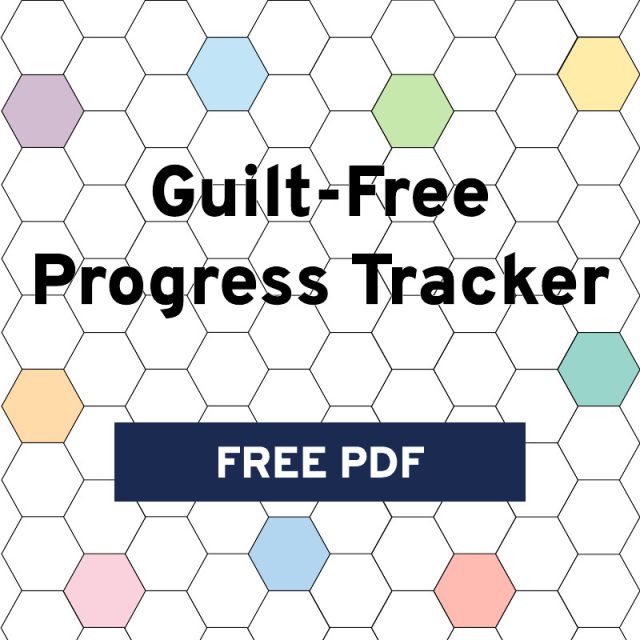
One Response
Hello Heather… thank you so much for providing both a text version and a video of this article. I was nearly put off when I saw the video at the top, until I realised the text is a full transcript. I really struggle to watch videos of this type. I think my ADHD loses focus long before the videos get to their point. But the text meant I could quickly determine that there was content I am interested in and where in the video it was.
Love the hexagon tip itself. I will definitely try this.